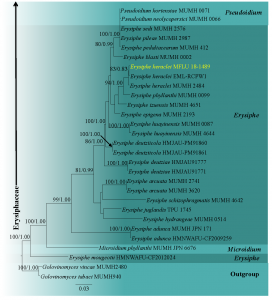Erysiphe R. Hedw. ex DC., in Lamarck & de Candolle, Fl. franç., Edn 3 (Paris) 2: 272 (1805)
Index Fungorum number: IF 1898
Erysiphe is typified with E. polygoni. Erysiphe is the largest genus in the Erysiphaceae and includes more than 50% of the family (Takamatsu et al. 2015). Erysiphe mainly consists of powdery mildew pathogens. Erysiphe species cause serious diseases on economically important plants such as cereals, crops, vegetables, flowers, fruit trees and ornamental plants (Braun & Cook 2012, Abasova et al. 2018b). An updated phylogenetic tree for Erysiphaceae species with new records is presented.

Phylogram generated from maximum likelihood analysis based on combined LSU and ITS sequence data. Twenty-nine strains are included in the combined analyses which comprised 1432 characters (806 characters for LSU, 622 characters for ITS). The evolutionary model GTR+I+G was used as the model for all the genes.Tree topology of the maximum likelihood analysis is similar to the Bayesian analysis. The best RaxML tree with a final likelihood value of -6405.264052 is presented. Estimated base frequencies were as follows: A = 0.237207, C = 0.237737, G = 0.292866, T = 0.232190; substitution rates AC = 1.004461, AG = 2.056312, AT = 1.198273, CG = 0.588661, CT = 4.363283, GT = 1.000000; gamma distribution shape parameter a = 0.177556. Bootstrap support values for ML greater than 75% and Bayesian posterior probabilities greater than 0.95 are given near nodes respectively. The tree is rooted with G. vincae (MFLU 16-1179 and CBS 236.34). Ex-type strains are in bold and black. The newly generated sequences are indicated in yellow.
Species
